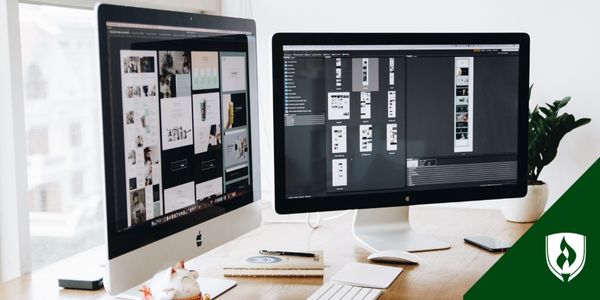Is Graphic Design a Good Career? What I Wish I Knew BEFORE Becoming a Graphic Designer ...
By Brianna Flavin on 05/19/2023

Isn't hindsight always 20/20? If only you could travel back in time and give younger-you some choice advice. Nothing to alter the time-space continuum of course, just a few tips to make things a little easier.
When you are considering a career, that kind of 20/20 vision would be very helpful. Will it help you support yourself and the people you love? Will you like it? Graphic design looks like a pretty cool career from the outside, but what will you think once you’re inside?
You probably won't get that kind of clarity typing “is graphic design a good career?” into the void. Good careers are a balance of your preferences, finding the right opportunities and developing the skills you need to keep advancing.
Will graphic design be a good career for you? Only you will know. But hearing from graphic designers about what this career is really like can go a long way to help you make your decision.
If you are considering a Graphic Design degree, get the details on what this career is like from within. We've gathered graphic designers to share some of the things they wish they'd known before they started on their career paths.
Before becoming a graphic designer, I wish I’d known…
1. Great design is strategic
Making something beautiful just for beauty's sake is all well and good. But graphic designers don't make their careers out of bedazzling billboards.
“I wish more people understood the strategic and problem-solving nature of my work,” says Alysia Steingart, visual identity designer at Grove Brands.
“Good design goes beyond just aesthetics and plays a crucial role in creating a visual language that communicates information and ideas in a clear, concise, visually-engaging way in order to achieve specific goals.”
Graphic designers need to understand their client's needs and goals to create the visual communication that can meet that need, according to Eddie Deva, creative director at Pixelbull. “We need to solve problems, tell stories, and create meaningful connections between brands and their audience.”
Deva points out that in today's world, graphic designers use visual concepts and design elements to drive conversions—the primary reason companies hire designers in the first place.
2. You need to get serious about collaboration
It's easy to feel possessive about your designs or your ideas; but if you choose a career in graphic design, you'll be working closely with other people.
“I used to think that designers work alone,” Deva says. “As I worked with larger companies, I learned that designers, developers, and the marketing team need to collaborate closely. It was surprising but also exciting to see how much can be achieved through teamwork.”
Even if you become a freelance graphic designer, you'll be in constant collaboration with their clients, adjusting your work to respond to their feedback. And designers who work in an agency or an in-house environment will likely spend time collaborating with stakeholders as well as other graphic designers, writers and marketers.
3. The graphic design career path can go in many directions
If you ask graphic designers where they work, you'll probably get a mishmash of answers including things like agencies, in-house and freelance. Graphic design positions appear in all kinds of different environments. Some graphic designers work for one company for a long time, while others jump gig to gig.
It can be both exciting and confusing when you are trying to get into the industry. “There are numerous opportunities in the field of graphic design, from working in an agency to freelancing or starting your own business,” Deva says. Expect to work hard for what you want and build your network just like professionals in other fields do.
4. No designer is right for every project
“I went into this field thinking that a great designer can create for anyone,” says Shavanna Pinder, creative team lead at Geek Powered Studios. “When in reality, a client and designer pairing is much like any other close relationship; styles, temperaments, and values should complement each other.”
While you may not always have the choices you'd like, trying to communicate big picture concepts right at the start with clients might help you decide whether you want to take on the project. “I've created some pieces at the insistence of the client that I would never publicize that I made,” Pinder says.
“It's better for everyone—and a lot more enjoyable—when you and the client are on the same wavelength.”
5. Sometimes you need to educate other professionals
Graphic designers put a great deal of work into pieces that (when done well) seem deceptively simple. Sometimes people outside the field assume great graphic design is much easier and faster to create than it really is.
The combination of creative skills, technical proficiency, understanding of visual communication takes years to master with constant practice, according to Steingart. “When clients or colleagues don't fully appreciate the value and effort that goes into creating good design, it can be frustrating.”
Designers who are passionate about their work often need to educate their clients or colleagues about why high-quality pieces, and the time it takes to make them, are a good investment.
6. You’ll need to help manage expectations
You know how long a project is likely to take—all the steps between conception and execution. You know how design choices are likely to play out in a finished product and what the aesthetic impact will be. Your client or boss does not necessarily know these things.
“When clients ask for seemingly small adjustments, it likely isn’t something you can fix in just a few minutes,” says Anna Bacon, graphic design specialist at Adduco Communications.
“Design takes a lot of time and care, and sometimes you’ll have to explain this to an impatient client more than once.”
A successful graphic designer is also a powerful communicator. And since you are the professional who understands graphic design principles and parameters—the job of managing expectations from clients or managers comes down to you.
7. Responding to data is an important part of the job
Increased interest in using data analytics to make more informed choices seems to be a trend across hundreds of careers—and the same is true for design.
“Even though specializing is important, designers are expected to be a jack-of-all-trades,” Pinder says. “The latest addition to your toolset is being able to dive into data and analytics and make informed decisions based on the results.”
A course, an online module, anything you can do to add a little data analytics understanding to your repertoire could be very helpful in your job hunt and your design career.
8. You don't have to be an amazing artist
This one might be shocking. Many graphic designers come to the field from a love of traditional art mediums. But that isn't a requirement by any means. “You don’t have to be an artist to be a graphic designer,” says Kieren Colquitt, lead graphic designer at Sood.
“I used to always think I had to be good at all aspects of art to be a graphic designer. In reality, it’s such a broad field that anyone can find their niche within it.” If you struggle with drawing or don't care for photography, you can still be awesome in graphic design.
“Just because I don’t know my way around a paintbrush, doesn’t mean I can’t design a slick website,” Colquitt says. “Try a bit of everything until you discover what you’re best at.”
9. “Graphic designer” isn't your only job option
A graphic design career can involve a ton of different roles beyond graphic design jobs. Graphic designers develop a versatile skill and education base that offers opportunity in plenty of fields.
“Your graphic design skills are transferable to other occupations that you might not have taken into consideration!” Colquitt says. “Web design is my specialty, but there are plenty of graphic designers who work in other roles such as packaging design, building environment design, and motion design. With graphic design, you’ve got options.”
At the start of her career, Bacon worked on the usual digital and print design projects. “But over time, I started looking into what else I could learn. Now, I do illustration, motion media, and I’ve just started learning how to use Blender® to create 3D objects.”
UI and UX designers as well as web designers can come from a graphic design background, and once you've been a professional graphic designer for a while, you can also consider positions like creative director or art director.
If creating and designing is still your dream job, you can also make a great career out of getting super adept in specific aspects of graphic design, Deva says. “It's not about limiting yourself, but rather finding your niche and contributing the most to the field.”
10. Your style will evolve over time
Sometimes professionals in creative jobs feel pressure to have a distinct style or aesthetic they can bring to their employers or clients, but your skills and preferences will grow as you gain experience. “Believe in yourself!” Bacon says. “When I was in college, I’d look around and feel like everyone was so much better than me.”
“But over time I’ve found my own style and learned how to take what’s in my mind and accurately put it on paper,” Bacon says.
11. You never stop learning
Whether you get a graphic design degree or teach yourself graphic design, the initial education is really only the beginning.
“I knew design was an interesting field and that I’d enjoy what I do, but working in a creative environment has really pushed me to be more curious and learn what other skills I can acquire,” Bacon says.
Besides, the more you learn, the more versatile and valuable your work will be. There are several potential opportunities out there for employees with experience in more than one area. You never know where a little extra know-how can take you.
Is graphic design a good career?
Graphic design is not a good career for every single person out there. Your fascination and interest matter. “If it is your passion, it’ll take a lot of patience and hard work, and it will definitely humble you, but it’s so worth it,” Bacon says. If you get excited about diving into color theory, balancing space and gaining skill with design programs, you might absolutely love this career.
Harness that energy and use it to launch into some learning! Experience counts for so much in your graphic design abilities.
But there's more to consider when you choose a career. Can you support yourself as graphic designer? Do graphic designers have good career advancement options? Learn more about some common outcomes in our article “ What Can You Do with a Graphic Design Degree? Exploring Your Options.”
Related Articles:
- 6 Compelling Reasons Why Graphic Design Internships are Important
- Should I Be a Graphic Designer? 6 Questions to Help You Find Your Answer
- 9 Perks of Being a Graphic Designer You Shouldn't Overlook
EDITOR'S NOTE: This article was originally published in 2013. It has since been updated to include information relevant to 2023. Some insight remains from original piece.
Blender is a registered trademark of the Blender Foundation.




